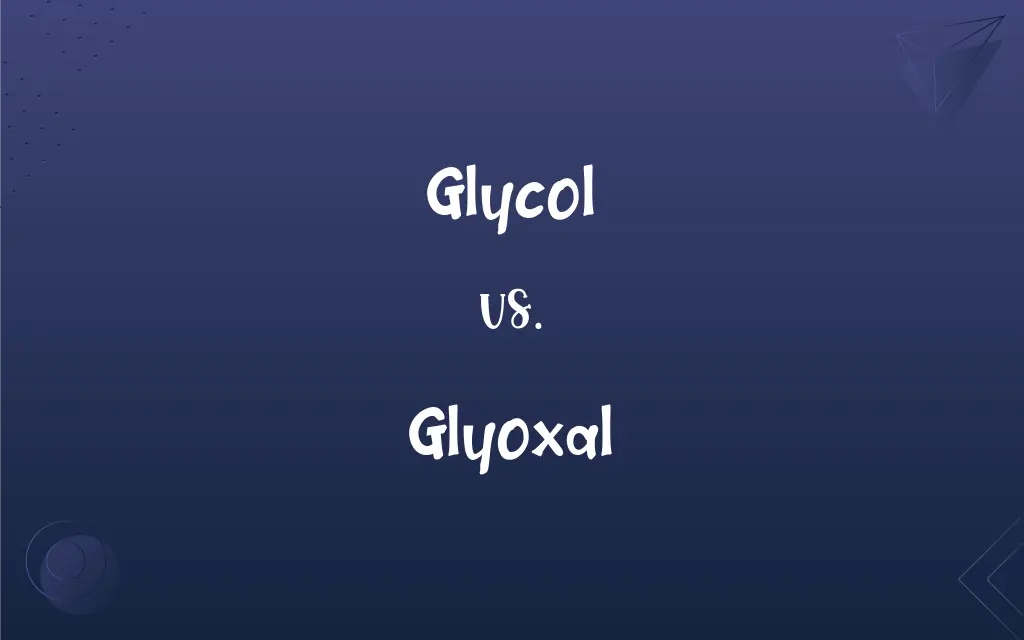Glycol vs. Glyoxal: What's the Difference?
Edited by Aimie Carlson || By Janet White || Published on January 11, 2024
Glycol is a type of alcohol with two hydroxyl groups, commonly used as antifreeze; glyoxal is an organic compound with two aldehyde groups, used in textiles and polymers.

Key Differences
Glycol, specifically ethylene glycol, is a type of diol or dihydric alcohol with two hydroxyl (-OH) groups. Glyoxal, on the other hand, is an organic compound characterized by two aldehyde (-CHO) groups.
In industrial applications, glycols are widely used as antifreeze agents due to their low freezing points. Glyoxal finds its applications in textile and polymer industries as a crosslinking agent due to its reactive aldehyde groups.
Glycol is known for its sweet taste and is toxic if ingested, posing health risks. Glyoxal, while also toxic, is primarily hazardous due to its irritant properties and potential to form harmful derivatives.
The chemical stability of glycol under normal conditions makes it suitable for use in various cooling and heating systems. Glyoxal, being more reactive, is used in manufacturing resins and as a chemical intermediate.
In terms of environmental impact, glycols can pose a risk due to their toxicity and persistence. Glyoxal, albeit less studied, is known for its biodegradability but can react in the environment to form other compounds.
ADVERTISEMENT
Comparison Chart
Chemical Structure
Contains two hydroxyl (-OH) groups
Contains two aldehyde (-CHO) groups
Common Use
Antifreeze in cooling systems
Crosslinking agent in textiles, polymers
Toxicity
Toxic if ingested, sweet taste
Toxic, irritant properties
Chemical Reactivity
Chemically stable under normal conditions
Highly reactive, used in resin production
Environmental Impact
Toxic and persistent
Biodegradable but forms reactive compounds
ADVERTISEMENT
Glycol and Glyoxal Definitions
Glycol
A key ingredient in hydraulic fluids.
Glycol-based fluids are essential in hydraulic systems.
Glyoxal
A compound used as a coolant and antifreeze.
Glycol is added to water in cooling systems to lower the freezing point.
Glycol
A component in the manufacture of polyester fibers.
Glycol is used in producing polyester fabrics.
Glyoxal
A diol with two hydroxyl groups.
Ethylene glycol is commonly used in car antifreeze.
Glycol
A diol with two hydroxyl groups.
Ethylene glycol is commonly used in car antifreeze.
Glyoxal
A sweet-tasting, toxic substance.
Despite its sweet taste, glycol is harmful if ingested.
Glycol
A compound used as a coolant and antifreeze.
Glycol is added to water in cooling systems to lower the freezing point.
Glyoxal
A key ingredient in hydraulic fluids.
Glycol-based fluids are essential in hydraulic systems.
Glycol
A sweet-tasting, toxic substance.
Despite its sweet taste, glycol is harmful if ingested.
Glyoxal
A component in the manufacture of polyester fibers.
Glycol is used in producing polyester fabrics.
Glycol
Any of various diols, usually containing vicinal hydroxyl groups.
Glyoxal
(organic compound) The dialdehyde ethanedial derived from ethylene glycol; it is used in the preparation of modified starch for the paper industry.
Glycol
Ethylene glycol.
Glyoxal
A white, amorphous, deliquescent powder, (CO.H)2, obtained by the partial oxidation of glycol. It is a double aldehyde, between glycol and oxalic acid.
Glycol
(organic chemistry) Any aliphatic diol.
Glycol
(organic compound) A thick, colourless liquid, C2H4(OH)2, of a sweetish taste, produced artificially from certain ethylene compounds and used as an antifreeze; ethylene glycol.
Glycol
A thick, colorless liquid, C2H4(OH)2, of a sweetish taste, produced artificially from certain ethylene compounds. It is a diacid alcohol, intermediate between ordinary ethyl alcohol and glycerin.
Glycol
A sweet but poisonous syrupy liquid used as an antifreeze and solvent
Glycol
Any of a class of alcohols having 2 hydroxyl groups in each molecule
FAQs
Is glycol toxic?
Yes, glycol is toxic if ingested, despite its sweet taste.
How is glycol used in cooling systems?
It's mixed with water to prevent freezing and overheating in cooling systems.
What is glycol?
Glycol is a dihydric alcohol with two hydroxyl groups, often used as antifreeze.
What are the safety concerns with glyoxal?
Glyoxal is an irritant and can be toxic, requiring careful handling.
Is glycol biodegradable?
Glycol can be persistent in the environment, posing ecological risks.
What is glyoxal?
Glyoxal is an organic compound with two aldehyde groups, used in textiles and polymers.
What are the uses of glyoxal in industry?
It's used as a crosslinking agent and in synthesizing resins and other chemicals.
How does glyoxal interact with polymers?
It acts as a crosslinking agent, enhancing the properties of polymers.
Why is glycol used in antifreeze?
Its low freezing point makes it ideal for lowering the freezing point of liquids.
How is glycol produced?
Glycol is typically synthesized from ethylene through chemical processes.
Can glycol be used in pharmaceuticals?
Certain types of glycols are used in pharmaceutical formulations.
What precautions are necessary when handling glyoxal?
Use protective gear and work in well-ventilated areas to avoid irritation.
Can glyoxal be used in food processing?
Generally, glyoxal is not used in food processing due to its reactivity.
Is glyoxal environmentally friendly?
Glyoxal is biodegradable but can form reactive compounds in the environment.
What are the health risks of glycol?
Ingestion can lead to serious health issues like kidney damage and toxicity.
What is the chemical formula of glyoxal?
Glyoxal's chemical formula is C2H2O2.
Can glycol be used in food?
Some glycols, like propylene glycol, are used in food, but ethylene glycol is toxic.
How does glyoxal affect fabrics?
It improves fabric qualities like wrinkle resistance in textile finishing.
Is glycol found naturally?
Glycol compounds can be found in natural processes but are mostly synthetic.
What industries use glyoxal?
Mainly the textile, polymer, and chemical manufacturing industries.
About Author
Written by
Janet WhiteJanet White has been an esteemed writer and blogger for Difference Wiki. Holding a Master's degree in Science and Medical Journalism from the prestigious Boston University, she has consistently demonstrated her expertise and passion for her field. When she's not immersed in her work, Janet relishes her time exercising, delving into a good book, and cherishing moments with friends and family.
Edited by
Aimie CarlsonAimie Carlson, holding a master's degree in English literature, is a fervent English language enthusiast. She lends her writing talents to Difference Wiki, a prominent website that specializes in comparisons, offering readers insightful analyses that both captivate and inform.































































